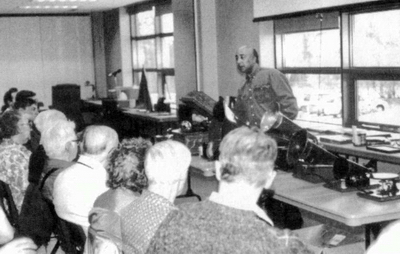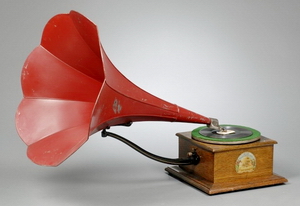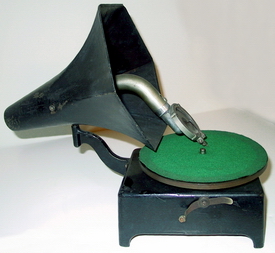|
Phonograph 'Show and Tell'
March 1998 Meeting Presentation
by Mike Bryan
Mike Bryan describes some of the rare machines on display

|
|
For the third time in as many years CAPS members
were asked to bring out some of their prize phonographs
for the March meeting. As usual they
responded with enthusiasm and provided the presenter
with some unusual and interesting machines to talk
about.
Before doing so, however, the scene was set with a few
facts about Canada in the era during which the
phonograph was developed. For example, in 1896 gold
was discovered in the Yukon and the Klondike gold rush
began. In the 1890s houses in urban areas generally had
water and sewer services and by 1900 electricity and
telephones were being installed in new upper and middle
class houses. The bicycle became common around the
time, perhaps because, "Unlike a horse, a bicycle could
be easily stabled and left no manure."
In contrast to the depressed times of the 90s, Canada
enjoyed its first great economic boom in the early 1900s,
fueled mainly by the success of its wheat which was
needed to feed the emerging industrial societies of
Canada and Europe. The population of Canada grew
from 5.4 million in 1901 to 8.8 million by 1921 with the
vast majority living in Ontario and Quebec. By 1911
there were 20,000 motor vehicles on Canadaís roads,
some of which would have been built by McLaughlin of
Oshawa, later to be absorbed into General Motors. A
hotel room was $1 per night, a 100 lb bag of flour $2.80
and a suit of fleece-lined, reinforced underwear could be
had for less than $2. The earliest machine on display at
our meeting was priced at $15 by Emile Berliner in
1895. It is doubtful that many people struggled with the
choice between buying 7.5 suits of underwear or a
phonograph, but the relative prices provide some perspective.
Anyway, letís start with that machine:-
Berliner Hand-Crank Gramophone, ca. 1895

|
|
Berliner Hand-Crank Phonograph, c 1895 (Owner: Domenic DiBernardo)
This machine represented Berlinerís first attempt at
commercialization of his invention after he received a
patent for his 'Gramophone' in 1895. He needed
financial backers for further development, so the visibility and
success of this machine was critical to the future of his
business. Reminiscent of the earlier German Kammer
and Reinhardt toy gramophone, designed by Berliner, his
own phonograph played only 7" hard rubber discs with a
playing speed of about 80 rpm. Crude though it was and
difficult though it was to achieve any kind of constant
speed with hand power, Berliner managed to attract
sufficient investment to incorporate the Berliner
Gramophone Company.
An alternative to hand power had to be found. Unlike
Edison who, for a while seemed to try every alternative
power source except the spring motor, Berliner
experimented briefly with battery power, then moved on
quickly and by the fall of 1896 produced his first spring motor
gramophone.
Edison Standard with Bettini
Micro-Attachment ca. 1898

|
|
Edison Standard with Bettini Micro-Attachment ca 1898 (Owner: Domenic DiBernardo)
Last year when we presented Domenicís Bettini #8
Phonograph, we learned about the Italian military officer,
Gianni Bettini and his drive to achieve better sound
reproduction of the operatic music that he loved. The #8
machine was made by Bettini after he moved from the
USA to France in 1902 to develop and promote his
products in Europe.
While living in the USA Bettini bought an Edison Class
M phonograph and was disappointed in the quality of
sound. He set out to find a way of improving
the reproduction, developing and patenting his Micro Reproducer.
This was marketed as a high end product to the discriminating listener seeking the very best sound reproduction. The large floating reproducer was expensive and not widely dispersed. It does turn up from time to time on
Edison and Columbia cylinder machines of the late
1890s, with or without the usual Bettini red steel cone /
aluminum bell horns.
Busy Bee 'Grand' 1906-9 (Owner: Horst Weggler)
By 1904 many companies were seeking to profit from
the mass market for machines and records created by the
giants, Edison, Victor and Columbia.
In Chicago Arthur OíNeill formed the OíNeill-James
Company with this purpose in mind. The first phonograph
introduced by the new company was essentially a Columbia Q, but with a
slightly larger mandrel so that standard Edison and
Columbia cylinders could not be played on it. It was
called the 'Busy Bee' after one of OíNeillís staff by the
name of Sherwin Bisbee.
Busy Bee 'GRAND'

|
|
In 1906 the company introduced the Grand Busy Bee
disc machine, a simple oak model with the reproducer
attached directly to the front mounted horn. It was
made for the OíNeill-James Company by Hawthorne and Sheble and
designed with a special lug in the turntable that made it
impossible to play anything but a Busy Bee record which
was made with a hole to accommodate the lug. The lug
hole was located in the label area of the record, thus not
affecting the discís ability to be played on a standard
machine.
O'Neill took this interesting marketing idea even further
with his 'Aretino' machine which had a 3" centre spindle
and correspondingly odd looking doughnut-like records.
In the end though, Victor and Zonophone decided to stop
making discs for O'Neill and then managed to tie up
Hawthorne and Sheble in litigation. OíNeill turned to
Columbia for supply and managed to keep going with the
Yankee Prince and Aretino models until his company was
absorbed into the Consolidated Talking Machine
Company in 1916.
Wonder Talking Machine ca. 1912 (Owner: Don Scafe)
Little is known about this machine apart from the fact
that it was made in New York. All we know is that the
machine has a swivel reproducer that permits Pathe as
well as standard discs to be played. Beyond that, we are
simply left 'wondering'. If any reader has more information
about the Wonder Talking Machine Company, the
author of this article and the owner would be interested in
learning it.
Wonder Talking Machine

|
|
U-S Rex ca. 1912 (Owner: John Peel)
In 1996 John brought out his U-S Junior model
and this was written up later in APN. This time
John displayed an internal horn model, the Rex.
The U-S Phonograph Company developed out of
the Cleveland Phonograph Record Company, producing
U-S Everlasting 2 and 4 minute cylinders
by artists such as Billy Murray, Ada Jones, Henri
Scott and Guiseppe Peratori. In just 3
years the company issued some 1,100
titles. It started making machines in
1910, first with the Phonola A and B
internal horn machines and soon with
12 more models. Four were also sold
through the Montgomery Ward catalogue under the 'Lakeside' label. Less
than 2,000 of each model were made
before Edisonís relentless lawsuits on
alleged patent infringements drained
the company until it went out of business in 1913. You may recall that
Edison never actually won any of his
lawsuits and that it was U-S that took
some small consolation in suing Edison
over the 'Opera' name. That is the reason why the Edison Opera was
renamed 'Concert' in 1912.
Coronet Toy Gramophone Late 1920s ( Owner: Don Scafe)
Coronet Toy Talking Machine

|
|
The disc gramophone entered this world as a toy when
Emile Berliner returned to Germany and sold his
gramophone idea to Kammer and Reinhardt. This company produced a hand powered machine that was quite popular until
Berliner came out with his first spring
driven machine aimed at the adult market, as described
above.
The Kammer and Reinhardt toy machine
lasted from 1890 to about 1894, after
which the spring driven style of machine
took over and the childís toy idea got lost
in the battle for supremacy in the adult
main stream market for machines and
records. It wasnít until the mid 1920s,
when the advent of radio had cooled the
intensity of the battle, that toy phonographs appeared again. Bing and Nirona
are two of the names that show up most
often on these small tin machines, often with the type of
large bell shaped sound box seen on this Coronet.
PAL Late 20s/Early 30s (Owner: Cecil Byers)
This was another hard to identify machine from New York.
This portable gramophone
is only 3" - 4" deep and has a
small aluminum horn attached directly to the reproducer.
The horn faces backwards so that the sound is reflected
off the lid in its open, vertical position.
Looking at these wonderful machines reminds us that,
although Edison, Victor and Columbia were so dominant
in the first quarter of the 20th century, there was still room,
at least on a temporary basis, for many imaginative and
innovative designers and marketers to make their mark.
Their originators would likely be amazed that their
machines still exist nearly a century later and that there
are people like us who can still derive great pleasure
from them.
Special thanks to Domenic
DiBernardo, John Peel, Don
Scafe, Horst Weggler and Cecil Byers for bringing out
their machines. Their effort was much appreciated
by the 70 members at the CAPS March meeting.
|